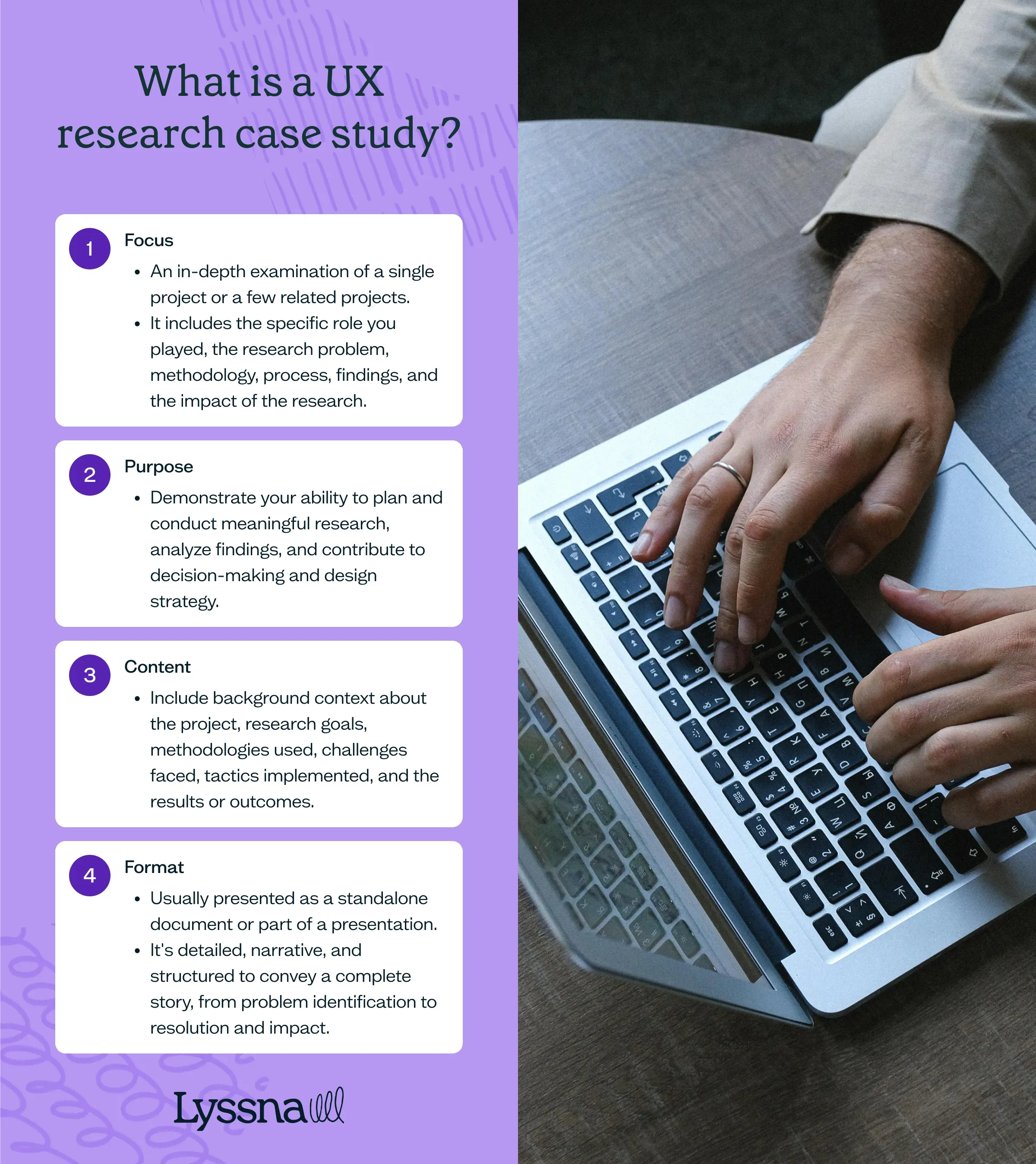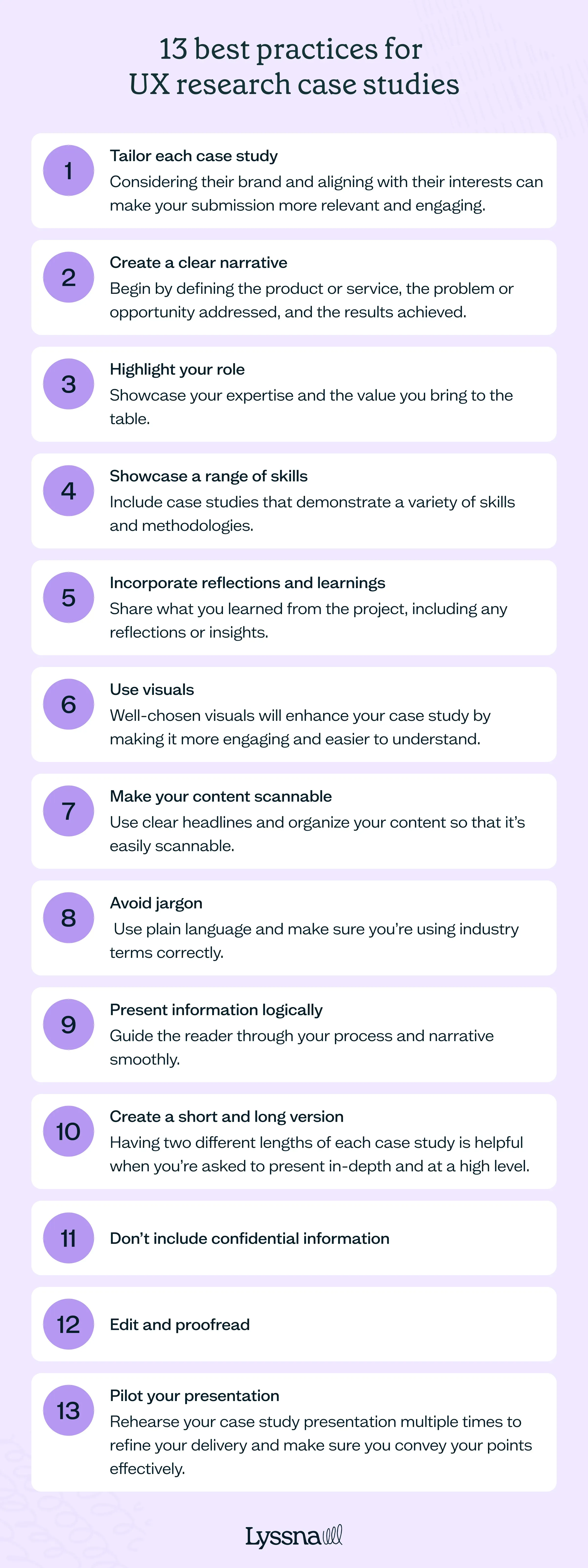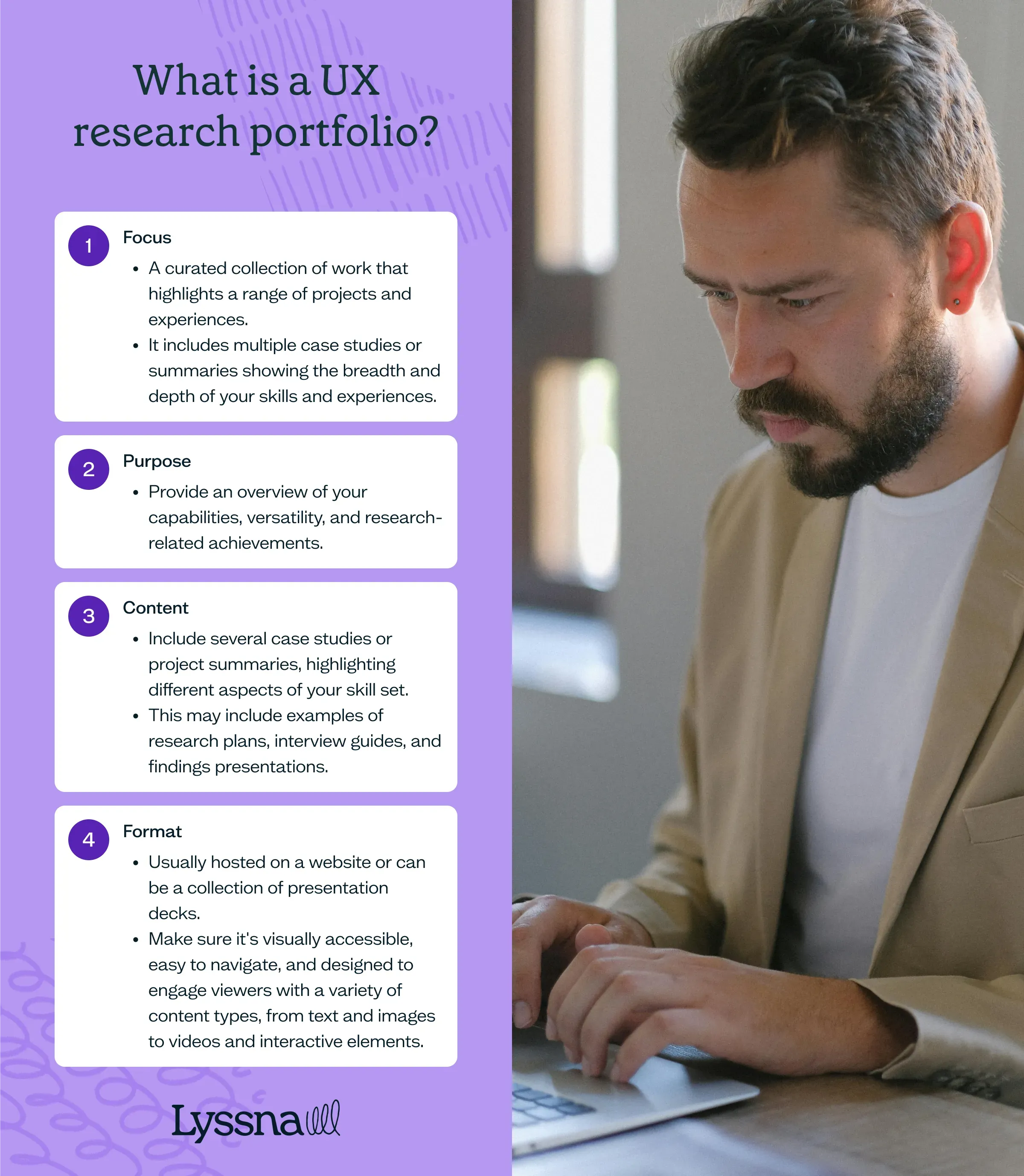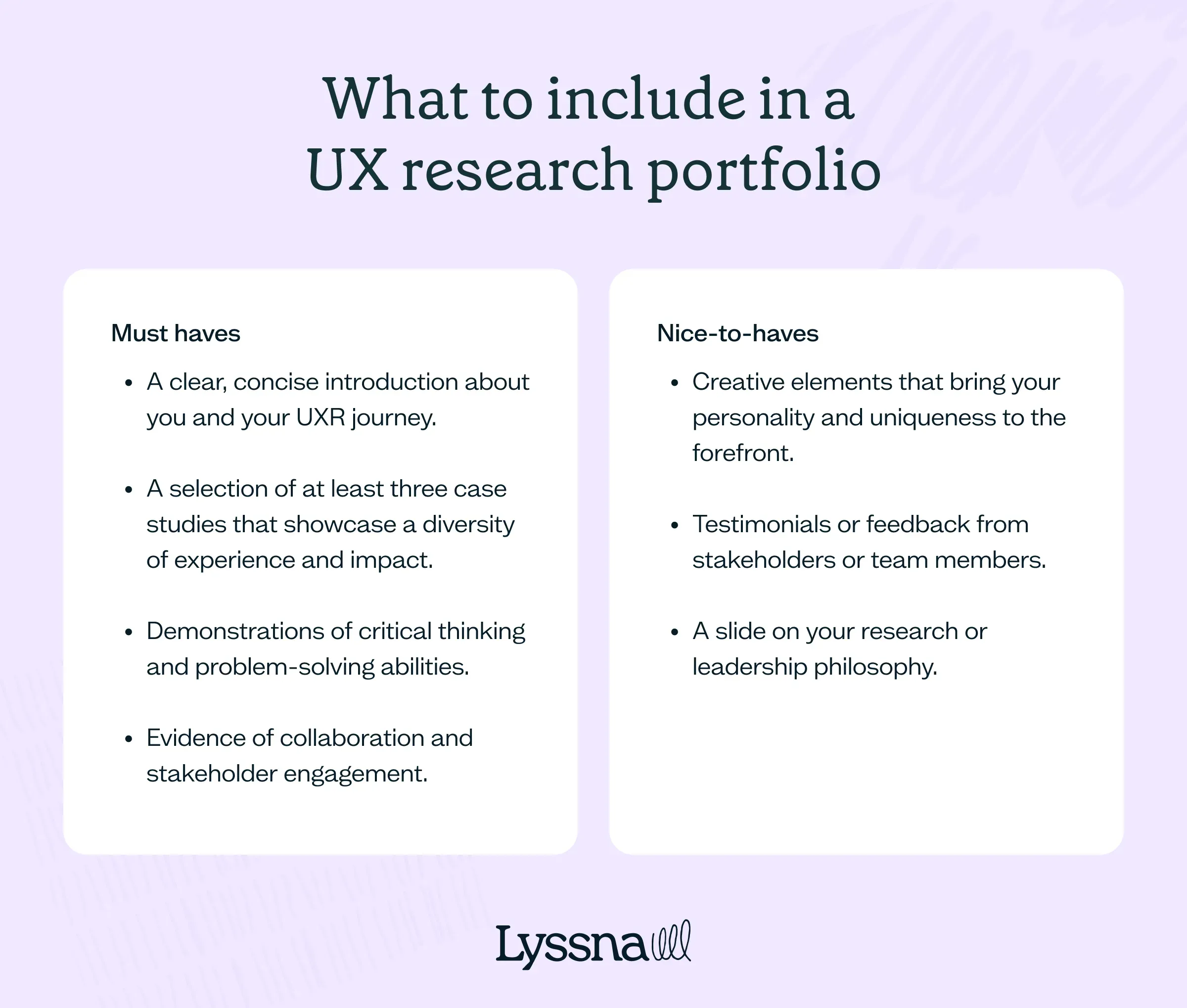14 Nov 2025
|12 min
UX research case studies
Discover how to craft compelling UX research case studies that highlight your expertise and creativity, making you stand out to potential employers and clients.

Crafting compelling UX research case studies isn’t just an exercise – it’s an essential way to showcase your expertise, creativity, and alignment with potential employers or clients.
Whether you’re a full-time employee, a manager, or a consultant, case studies are your ticket to standing out during the hiring process.
In this article, I explore what UX research case studies are, how to write them, how to present them, and share some best practices. I also touch on UX research portfolios, explaining what they are and what they should include.
Let's make your UX research case studies and portfolios as impactful as possible.
Elevate your research practice
Join over 320,000+ marketers, designers, researchers, and product leaders who use Lyssna to make data-driven decisions.
What is a UX research case study?
Whether you’re applying for a junior, mid, or senior-level role, case studies are pivotal. They act as a direct window into your ability to navigate user research complexities, presenting a narrative of your journey, challenges, successes, and the tangible impact of your work.
While a case study provides an in-depth look at a specific research project or series of related projects, and demonstrates your process and impact, a portfolio offers a broader overview of your cumulative work and skills, incorporating multiple case studies and other evidence of your professional accomplishments.
We get into portfolios in a little more detail below. But first, let’s look at the purpose of UX case studies.
Focus: A UX research case study is an in-depth examination of a single project or a few related projects. It details the specific role you played and the research problem, methodology, process, findings, and impact of the research.
Purpose: The primary goal is to demonstrate your ability to plan and conduct meaningful research, analyze findings, and contribute to decision-making and design strategy. It's a deep dive into how you approach and solve problems.
Content: Your case studies should include background context about the project, research goals, methodologies used, challenges faced, tactics implemented, and the results or outcomes. Ideally, it should showcase aspects of your thought process, decision-making skills, and ability to drive change.
Format: Generally presented as a standalone document or part of a presentation. It's detailed, narrative, and structured to convey a complete story, from problem identification to resolution and impact.

How to write a UX research case study
1. Choose a focus
Organizations will likely provide you with a unique set of requirements when they ask for case studies. Use their prompts to inform the focus for your case studies, making sure they speak directly to the role you seek.
Here are some example prompts to give you a sense of what these requests might entail.
Ecommerce platform improvement: Please provide a case study that showcases how you've used user research to identify and overcome barriers in an ecommerce user journey, leading to improved conversion rates.
Mobile app usability enhancement: We'd like to see a case study where you've uncovered and addressed usability issues in a mobile app, emphasizing improved user navigation and task completion.
New market entry strategy: Share a case study demonstrating your approach to understanding and adapting a product for a new demographic market, including how you used user research to inform product adaptation and messaging.
Onboarding process optimization: Submit a case study that illustrates your work in evaluating and enhancing an onboarding process to increase user engagement and retention through user research insights.
Legacy system redesign: We're interested in a case study where you've conducted user research to guide the redesign of a legacy system, balancing modern user expectations with the retention of core functionalities.
Social media engagement: Provide a case study detailing how you've explored user engagement on social media platforms and suggested user-centric features or campaigns to boost engagement for a service.
Accessibility in healthcare apps: Showcase a case study where you assessed and improved the accessibility of a healthcare app for users with disabilities, including your research approach and recommendations.
SaaS product development prioritization: We'd appreciate a case study that shows how you used user research to identify and prioritize valuable new features for a SaaS product, influencing the product development process. For insights into designing user-friendly and impactful interfaces, explore SaaS UX design approaches.
Building user trust in fintech: Please share a case study focusing on how you investigated and addressed user trust and security concerns in a fintech service through user research. For inspiration on how to present these projects effectively, check out this example of ux design for fintech.
Content strategy evaluation: Submit a case study demonstrating how you've used user research to evaluate the effectiveness of a content strategy across various platforms and recommended improvements for better user engagement.
2. Add the building blocks
Include crucial elements such as the research goal, your approach, timeline, key takeaways, and most importantly, the impact of your work.
3. Tell a story
Your case study should narrate not just what you did, but how you approached challenges, collaborated with stakeholders, and the lessons learned along the way.
4. Reflect on the impact
Beyond results, focus on the broader impact of your research. How did it shape decisions, influence design, or drive strategy?

How to present a UX research case study
Presenting your case studies effectively is just as important as their content. The format you choose can significantly impact how your message is received. Here are some key considerations based on different formats.
PowerPoint, Google Slides, and PDFs
Choose a format that aligns with the company's ecosystem. For instance, use PowerPoint for Microsoft roles to demonstrate platform proficiency. Google Slides offers real-time edibility and instant updates. PDFs provide a static but universally accessible option.
If using slide decks, create a comprehensive master deck and tailor individual presentations to specific audiences, providing relevance and engagement.
Online platforms
Use platforms like Squarespace or Notion for ease of updating and the ability to track visitor engagement through analytics. Password protection adds a layer of security, ensuring only intended eyes see your work.
UX research case study best practices
As you craft your case studies, remember that the quality and clarity of your presentation can greatly impact its effectiveness and the impression it leaves on the audience.
Here are some guidelines to help you craft case studies that stand out and truly reflect your expertise.

Tailor each case study
Customize your case study to resonate with the specific audience and the company you're addressing. Considering their brand and aligning with their interests can make your submission more relevant and engaging.
If you’re pitching to a client, consider customizing your case study presentation to mirror the company's branding – colors, typography, style, mission, and the role you’re interested in. This helps to align yourself with their aesthetic, ethos, and goals in a subtle way.
Create a clear narrative
Begin by clearly defining the product or service, the problem or opportunity addressed, and the results achieved. This sets the stage for a focused narrative.
Highlight your role
Make your contributions and your role in the project unmistakable to showcase your expertise and the value you bring to the table.
Showcase a range of skills
Include case studies that demonstrate a variety of skills and methodologies. This illustrates your versatility and depth as a researcher.
Incorporate reflections and learnings
Sharing what you learned from the project, including any reflections or insights, adds depth to your case study, shows your capacity for critical thinking, and demonstrates a growth mindset.
Use visuals
Well-chosen visuals will enhance your case study by making it more engaging and easier to understand.
Make your content scannable
Use clear headlines and organize your content so that it’s easily scannable. This makes your case study more accessible and user-friendly to audiences who want a brief overview as well as those who are interested in just top-level information.
Also, don’t include every single learning or insight. Instead, focus on one or two key points.
Avoid jargon
Don’t overload your case study with jargon or unnecessary details. Use plain language and make sure you’re using industry terms correctly. I can tell immediately how research-savvy you are by the terms you use and misuse.
Present information logically
Make sure that your case study unfolds in a logical sequence, guiding the reader through your process and narrative smoothly.
Create a short and long version
Having two different lengths of each case study is helpful when you’re asked to present in-depth and at a high level. High-level may include a five-minute walkthrough (with a recruiter) and in-depth (around 20 minutes) when presenting to the hiring manager or a team.
Don’t include confidential information
Never present confidential or sensitive information. This alone could easily exclude you from further consideration.
Edit and proofread
Remember to edit and proofread for clarity and conciseness. The number of typos I see in case studies is mind-blowing. Ask a colleague or friend to proofread your work.
Pilot your presentation
Rehearse your case study presentation multiple times to refine your delivery and make sure you convey your points effectively.
Your go-to user research platform
The best teams use Lyssna so they can deeply understand their audience and move in the right direction — faster.
What is a UX research portfolio?
As mentioned above, UX research portfolios serve a slightly different purpose than case studies.
Focus: A portfolio is a curated collection of work that highlights a range of projects and experiences. It includes multiple case studies or summaries showing the breadth and depth of your skills and experiences across different contexts and challenges.
Purpose: Your portfolio should provide an overview of your capabilities, versatility, and research-related achievements. It's designed to give potential employers or clients a more comprehensive look at your work history and expertise.
Content: Include several case studies or project summaries, highlighting different aspects of your skill set. This may include examples of research plans, interview guides, findings presentations, and any other artifacts that demonstrate your competence. It shouldn’t include any confidential information, however.
Format: Portfolios are usually hosted on a website or can be a collection of presentation decks. Make sure it's visually accessible, easy to navigate, and designed to engage viewers with a variety of content types, from text and images to videos and interactive elements.

What to include in a UX research portfolio
Must-haves:
A clear, concise introduction about you and your UXR journey.
A selection of at least three case studies that showcase a diversity of experience and impact.
Demonstrations of critical thinking and problem-solving abilities.
Evidence of collaboration and stakeholder engagement.
Nice-to-haves:
Creative elements that bring your personality and uniqueness to the forefront.
Testimonials or feedback from stakeholders or team members.
A slide on your research or leadership philosophy.

Crafting effective case studies and portfolios
Remember, your UXR case studies and ux design portfolios are more than just a requirement – they're your platform to shine, demonstrating not only your expertise but also your passion for user research. As you compile your case studies, keep your audience in mind and don’t shy away from showcasing the uniqueness that you bring to the table. Whether you're applying for your next role or seeking to elevate your presence in the UXR community, these documents are your narrative, told on your terms.
Ready to elevate your UXR case studies? Start with the checklists above. Then reflect on your most recent, impactful, and diverse projects. You’ve got this!
--
This article was authored by Michele Ronsen, Founder and CEO of Curiosity Tank. Michele is a user research executive, coach and educator. She teaches design and user research to people around the world. Her corporate trainings and workshops are inspired by working with Fortune 500s and start-ups for more than twenty years. Fuel Your Curiosity is her award-winning, free, user-research newsletter. In 2020, LinkedIn honored Michele with a TopVoices award in the Technology category. She is the first and only researcher to receive this award.
You may also like these articles


Try for free today
Join over 320,000+ marketers, designers, researchers, and product leaders who use Lyssna to make data-driven decisions.
No credit card required






